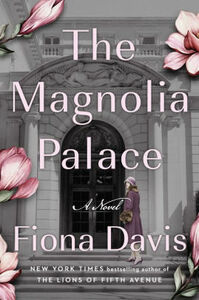Take a photo of a barcode or cover
Fun historical fiction, about equally divided between historical and fiction – as the author says, there is a true story with a completely fictional story laid on top of it. If you know New York artistic history or you’re a devoted listener to 99% Invisible, you’ll recognize the main character, a young woman who was the subject of the many early 20th century female statues that grace Manhattan’s parks and buildings. Her name was Audrey Munson. The character’s name is not Audrey Munson, because the main part of the plot is a complete “what if“ – what if this model and muse, sometimes called America’s first supermodel, came to work and live with the steel baron Henry Clay Frick’s family in the Manhattan mansion that housed his great art collection and later became an art museum and library? And what if there were a mystery? Or more than one?… The plot toggles back-and-forth between the early 20th and early 21st centuries, with parallel intrepid model heroines out of their depths and making their way from moment to moment by using their knowledge and wits (“models can read, you know“). If you know Manhattan and the Frick collection, you’ll have fun recognizing the surroundings. If you haven’t, you might want to go after reading this. Either way, no great work of literature, but recommended as a good, fun read.
emotional
hopeful
medium-paced
Plot or Character Driven:
Plot
Strong character development:
Yes
Loveable characters:
Yes
Diverse cast of characters:
Complicated
Flaws of characters a main focus:
Yes
At some point I felt like I had read this book for a second time. I do love learning about New York City since I used to live there and enjoy the historical fiction genre that Fiona Davis rated. While a touch predictable the story is interesting and intriguing enough to keep you coming back for more.
"The Magnolia Palace" by Fiona Davis takes some actual history related to the family of industrialist Henry Clay Frick and then adds a layer of fiction to produce a story that spans several decades. The novel touches upon the Fricks' lives, NYC mansion and art collection as well as on the lives of household staff members, racism and classism and more. When the book is good it's VERY good, but some of the dialogue feels flat and a few of the plot points are overly contrived. The premise is that a down-on-her-luck artist's model finds her way onto the Fricks' staff as a personal secretary to Frick's daughter Helen in 1919. That story is interspersed with the story of a 1960s model from England who accidentally gets locked in the Frick Mansion after an unsuccessful photo shoot.
emotional
mysterious
fast-paced
Plot or Character Driven:
Character
Strong character development:
Yes
Loveable characters:
Yes
Diverse cast of characters:
No
Flaws of characters a main focus:
Yes
Dear The Magnolia Palace,
You were so charming. I was completely transported into the world of the Frick Mansion and the twists and turns of the people who live within it's walls. I was enchanted with Lillian and the double life that she lived, torn between the world of figure modeling and legitimacy. I could not stop listening to you over the weekend. You drew me into your beautifully crafted world and exquisite characters. I loved the careful way the two timelines were drawn together, and how each one had its own intrigue. Fiona Davis is the queen of historical fiction.
You were so charming. I was completely transported into the world of the Frick Mansion and the twists and turns of the people who live within it's walls. I was enchanted with Lillian and the double life that she lived, torn between the world of figure modeling and legitimacy. I could not stop listening to you over the weekend. You drew me into your beautifully crafted world and exquisite characters. I loved the careful way the two timelines were drawn together, and how each one had its own intrigue. Fiona Davis is the queen of historical fiction.
I’m wondering whether I read the same book as all these glowing reviews describe. The beginning of this is dull. The 1966-based storyline is implausible. The Gilded Age dialogue is filled with modern turns of phrase that are ridiculously out of place in that era. Overall, the writing is on par with a talented college freshman, which makes me wonder if an editor did more than casually glance at this manuscript. Either way, the “New York Times Best Selling Author” appellation has clearly lost all cachet.
Historical fiction at its finest, this incredible story includes mystery, murder, betrayal and revenge all set among some the finest works of art in the world.
Lillian, also know as the renown model Angelica, hiding from a mistaken accusation of murder finds herself in front of bossy and difficult Helen Frick, who believes that she is there for a job interview. Miss Lilly begins to work with Miss Helen in the Frick residence, and she finds herself surrounded by secrets and lies.
Two timelines, from 1919 and 1966 intersect with an ending that merges the two time periods with a satisfying conclusion.
I thoroughly enjoyed this story, the characters were interesting, and likable, even the bullish Miss Helen. I highly recommend this book to all fans of historical fiction.
Thank you to Netgalley for the opportunity to review an advance reader copy of this book.
Lillian, also know as the renown model Angelica, hiding from a mistaken accusation of murder finds herself in front of bossy and difficult Helen Frick, who believes that she is there for a job interview. Miss Lilly begins to work with Miss Helen in the Frick residence, and she finds herself surrounded by secrets and lies.
Two timelines, from 1919 and 1966 intersect with an ending that merges the two time periods with a satisfying conclusion.
I thoroughly enjoyed this story, the characters were interesting, and likable, even the bullish Miss Helen. I highly recommend this book to all fans of historical fiction.
Thank you to Netgalley for the opportunity to review an advance reader copy of this book.
Like other books I've read recently, there are two stories within the novel. I enjoy that in the books I've read as I wonder how the stories will converge. The first storyline takes place at the early part of the 1900s and the other happens in the 1960s - far enough apart to be distinct but close enough that some characters eventually meet. Seeing where the lives of the two main characters twist and turn, where they land, how they converge, as well as solving the mystery that is behind those lives makes for a captivating story.
While the novel has actual elements and characters like Henry Clay Frick, the Frick museum and references to the artwork, it is not a book like Marie Benedict's where she researches and stays true to the real-life events. In this case Fiona Davis sets a totally fictional narrative against the backdrop of the Frick mansion. Davis clarifies this and tells readers what is based in fact and what she imagined and created in the afterword. The real people from history add a grounding in time; however, readers need to read that afterword or they may think they know more than they actually do from history. (That isn't a criticism, just an observation.)
I listened to the audio version of this novel and really enjoyed it. Karissa Vacker's narration was well done. She did a very good job of bringing the story to life as well as differentiating the characters. She made it quite enjoyable.
While the novel has actual elements and characters like Henry Clay Frick, the Frick museum and references to the artwork, it is not a book like Marie Benedict's where she researches and stays true to the real-life events. In this case Fiona Davis sets a totally fictional narrative against the backdrop of the Frick mansion. Davis clarifies this and tells readers what is based in fact and what she imagined and created in the afterword. The real people from history add a grounding in time; however, readers need to read that afterword or they may think they know more than they actually do from history. (That isn't a criticism, just an observation.)
I listened to the audio version of this novel and really enjoyed it. Karissa Vacker's narration was well done. She did a very good job of bringing the story to life as well as differentiating the characters. She made it quite enjoyable.
I enjoyed this book but was disappointed that the ending was too sugary and neat.




